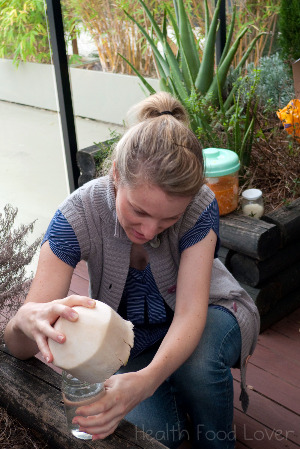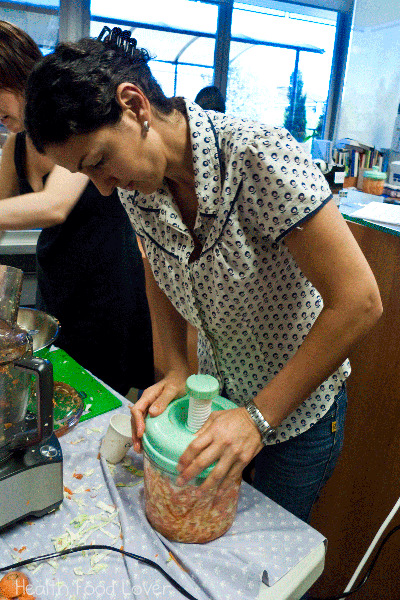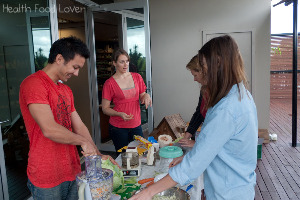I’m so happy to present this guest post on fermented foods by Helen Padarin, Naturopath. To read more about Helen go to the bottom of the post.
Guest Post: Helen Padarin on Fermented Foods
If I was asked, what is one of the single most important foods to be reintroduced into the regular diet, my answer would have to be fermented foods. “What on earth are they?† I hear you say!
Cultured, or fermented foods have been part of most ancient cultures for many centuries. In times gone by, foods were fermented as a way to preserve them, so that one would have supplies during the sparse cold months. Fermented foods were revered as having healing properties. The word “kefirâ€, Turkish in origin, actually translates to “feel goodâ€. Other traditional fermented foods include sauerkraut (Germany), miso (Japan), tempeh (Indonesia and Japan) and kim chi (Korea), beet kvass and kombucha. In a nutshell, fermented foods are produced by providing the right environment for lactic acid producing bacteria to grow. The lactic acid preserves the food and prevents putrefactive organisms from flourishing.
So why are fermented foods so valuable?Fermented foods provide a plethora of vitamins, minerals, enzymes and probiotics. They also have a bit of a tart or sour taste (a taste sorely missing from most modern diets) which stimulates the taste buds to send messages to the brain which send messages to the stomach to produce more digestive acids. So you get improved digestion from the enzymes and the acids.
Because the friendly bacteria – the lactobacilli – actually partially digest the food, the nutrients in it are easier for our body to absorb. Certain lactobacilli are also responsible for the manufacture of vitamins and minerals. As a result we gain much more vitamins and minerals from fermented foods than we do from raw or cooked foods. For example, you will absorb from 100 to 300 times more vitamin C from fermented cabbage than you will from raw or cooked cabbage! This increased absorption occurs with all the nutrients in the food.
More than 80% of our immune system is located in the lining of the gut wall. A large proportion of how our immune system reacts is dependant on the kind of microbes – bacteria, fungi, viruses etc – that are in our digestive tracts. Having the right kind of beneficial microbes there is essential for both healthy immune function, and healthy gut function. They protect us from allergies, asthma, eczema, autoimmune disorders, stomach, duodenal and mouth ulcers, digestive disorders and cancer to name but a few.
Unfortunately with the advent of refrigeration came the end of an era for regularly consumed fermented foods in most western cultures. Our bodies no longer get this daily intake of protective nutrients, enzymes and beneficial bacteria. This is one contributing factor to the massive rise in chronic digestive and immune disorders in the last few decades. One of the most beneficial food groups to include as part of your daily diet to regain and maintain optimal health is fermented food. They are also particularly beneficial for pregnant and breastfeeding women and, due to their anti-aging effect, anyone interested in longevity!
The catch is the joy – you have to make them yourself! Fermented foods do not lend themselves well to modern food manufacturing processes. As a result, most commercially available fermented foods – like sauerkraut, chutney’s etc, contain vinegar and have been irradiated and or pasteurised which nulls the beneficial bacteria, enzymes and vitamins. It can be great fun and very rewarding making your own fermented foods (and drinks) and you’ll find friends are intrigued and inspired by what you make!
Here’s a brief run down of a few different types of fermented foods and drinks:
Fermented veggies
Sauerkraut is just one of hundreds of fermented veggie options. Most vegetables can be fermented quite easily – goods ones to start with include carrot, cabbage, beetroot, cauliflower, parsnip and onion. Add delicious combinations of herbs and spices and you have a virtually endless variety of flavours to explore! You can even add some fruit, like grated apple or perhaps some dried goji berries to your fermented veggie recipes.
Kefir
Kefir is fermented milk (I use unpasteurised milk) it’s super easy to make and is one of my favourite summer breakfasts. It is similar to yoghurt, but packs more power in it’s punch. Kefir makes delicious smoothies with cinnamon and banana or berries. Or serve like a bowl of yoghurt, sweetened with stevia if you like, and topped with ground up pepitas, fresh blueberries and a good sprinkling of cinnamon.
Coconut Water Keifr (CWF)
 Made from the water in fresh young coconuts, CWF is great for kids and adults who have troubles with dairy. It gets quite fizzy and tastes delicious, so it makes an excellent alternative to soft drink. You can also make a coconut kefir “cheese†out of the flesh of the young coconut.
Made from the water in fresh young coconuts, CWF is great for kids and adults who have troubles with dairy. It gets quite fizzy and tastes delicious, so it makes an excellent alternative to soft drink. You can also make a coconut kefir “cheese†out of the flesh of the young coconut.
In the image: coconut water draining into a jar and fermented vegetables in the background.
Naturally Fermented Ginger Beer
Another family favourite and again full of good bacteria and enzymes and tastes delish.
Kombucha
Made out of sweet black or green tea, kombucha is a delicious, refreshing drink. Also very fizzy it makes a great alternative to soft drinks. Make it extra yummy by adding a piece of fresh lime or a slice of fresh ginger – heaven! It is excellent for the skin, liver and immune system. An excellent detoxifier!
Notes on introducing fermented foods into your diet:
When you start to bring these amazing foods into your diet, do so slowly! When you eat large amounts of fermented foods you are getting big troops of beneficial bacteria going in. These beneficial bacteria help to kill of opportunistic bacteria and yeast, such as candida. If you kill off a large amount all at once, you are likely to get some unpleasant symptoms, such as bloating, headaches, a hang-over feeling, excessive burping or flatulence – in other words your friends won’t want to be too close to you! Go slow, starting on a teaspoon or so per day and gradually build up the variety and quantity to a cup or so per day.
Recipe: How to Make Cultured Vegetables
You will need:
- ½ cabbage (approx)
- 1kg carrots (approx)
- A couple slices of peeled, fresh ginger
- Optional garlic (1-2 cloves) if desired, finely chopped.
- 1 teaspoon sugar
- Vegetable Culture Starter (see www.bodyecology.com)
- Vegetable press OR fermenting crock pot OR large glass jar with plate that can fit into the neck, weighted down
Directions:
- Sterilize all equipment using boiling water.
- Dissolve 1 sachet of Vegetable Culture Starter and 1 teaspoon of sugar in 1 glass of water. Set aside. The sugar will “wake up†the microbes in the culture starter, so they are nice and active when added to the vegetables.
- Grate all vegetables. Using a food processor makes this very quick and easy. For carrots use the grating attachment, for cabbage use the slicing attachment.
- Place grated vegetables in a large mixing bowl. Add the ginger and the cup of culture starter mixture. Mix all ingredients together thoroughly.
- Pack ingredients into vegetable press.
- With the compression platform wound up as high as it will go, place the lid on the vegetable press (you may need to use a little force to get the lid down and screwed on).
- Once the lid is on, wind the compression platform down as firmly as possible, so that the fluid completely submerges the vegetables.
- Leave out at room temperature for 5-10 days (5 days in summer, 10 days the rest of the year).
- It’s now ready to eat! Place in a large glass jar / container in the fridge, and it will keep for 8-10 months. Eat them alone as a snack, mix into salads or grains or have as a side dish with a main meal. Start with a small amount (eg 1 teaspoon / dessert spoon and build up to at least half a cup a day. Enjoy!
© Helen Padarin 2010
Note: The juice from a prepared batch can be used to start the next batch – instead of using culture starter every time. Just use the culture starter every few batches.
Have you tried fermented foods? What do you think?
_ _ _ _
About Our Guest
This guest post on fermented foods is by Helen Padarin. Helen is a Naturopath from Sydney who specializes in working with children and adults with conditions such as Autism, ASD, ADH/D and asthma. She aims to help treat people by prescribing a wholesome diet with fermented foods which helps support healthy gut and better immune function, detoxification and optimal nutritional status. You can find her at Nourish-ed.com and Pymble Grove Health Centre in Sydney. She also runs fermented food workshops in Sydney. Next workshop is July 3rd: fermented foods workshop pdf. I hope you enjoy her post and get excited about fermented foods! Thanks Helen.
Michelle.
[photo credit: Tayana Kildisheva]
Like this post? You may also like:
Â
This post was shared at Fight Back Friday, Vegetarian Foodie Fridays





















{ 22 comments… read them below or add one }
Thanks for linking through to my site recently healthfoodlover
I really enjoy reading your posts, thanks for this one too.
That’s okay Carlie. It’d be great to see you back at Wholesome Whole Foods blog carnival today. Just don’t forget to link back to the carnival in your post.
Cheers.
This was a great read. I really do need to start eating fermented veggies. I know I’d like them. I just need to take the time to do it. I guess pickles don’t count do they? (just joking) Thanks for linking up with me today!
Hi Melodie,
I’m glad you enjoyed the article. It’s really easy to make fermented veggies – it’s just the unfamiliar factor that takes some of us a while to get around to making them! Once you do though, you’ll realise how simple it is – so jump in and get started!
Unfortunately almost all commercially made pickles and ferments are made with vinegar and or they have been irradiated and or pasteurised, which kills all the wonderful beneficial bacteria and enzymes that we want from the foods!
Happy fermenting!
Hi chele! Happy friday! I just saw this article and I love love love it! Sharing it on my Thoughts on Friday link love post here: http://amoderatelife.com/?p=266 I have been making and using various fermented foods for a while and i really notice a difference if i go even a day or so without them! Have a great weekend!
Hey Alex. You’re so sweet thanks so much for sharing Helen’s guest post in your Thoughts on Friday.
Hi Alex! I’m glad you loved the article, and thanks so much for sharing it on your own site – much appreciated!
I really notice when I don’t get to have my fermented foods too – it’s the one food group I crave the most, particularly if I’m travelling and haven’t had access to them as easily!
Would love for you to share your fermented foods experiences with our facebook group too – http://www.facebook.com/Nourish-ed – we’re aiming to change the world one fermented veggie at a time! ;)
What an awesomely informative post!! There’s so much to take in, I’m saving it for reference in the future. I’m so excited to further my endeavors in natural fermentation =)
Hi Girlichef!
I’m glad you liked the post! I look forward to hearing how your first batch of fermented veggies (or other fermented delights) goes! Keep us posted on http://www.facebook.com/Nourish-ed ! We’d love to hear how you go and we love when people share their experiences!
something i want to try and add to my diet.
Do it! :) So worth it! And let us know how you go with it on http://www.facebook.com/Nourish-ed – share your experience and inspire others to follow!
Enjoy!
Hi, Helen. We met on Anne’s birthday, remember? =) I enjoyed this post. I’ve been bandying about the idea of learning how to ferment food… My husband just developed gastritis though (an inflammation of the stomach lining), so I don’t know if it’s something that would benefit him or make it worse. Do you have an opinion about that? Also, is the July 3rd workshop in Sydney or Wellington?
Hi Julie!
Of course I remember! Thankyou for the drawing experience! We have been having a play at that several times since! Always lots of fun!
I’m glad you like the article. Gastritis is a certain indication that there are not enough beneficial bacteria lining and protecting the gut wall, so it is more than likely the fermented veggies would be fantastic for your husband. Just start him on a low dose of a teaspoon per day and slowly build up until he’s having half a cup to a cup.
The July 3rd workshop was in Sydney. Hopefully we’ll have another Wellington one later in the year! Otherwise let me know if I can help in the meantime.
I hope you’re well,
Helen.
I guess that I’m going to have to start adding fermented foods into my diet. I take acidophilus capsules from time-to-time, but this looks like a much more natural, effective approach. Unfortunately, I do not like yogurt, but I LOVE ginger beer!
Hi Dave,
Yep – it does sounds like the right stuff to add to your diet! But then I’d say that to almost anyone! Seriously though, fermented foods are so powerful and effective at supporting digestive and immune function (among many other things). If you have trouble with candida it’s essential to use these medicinal foods. Since using fermented veggies as part of treatment protocols for candida, effectiveness of treatment has sky-rocketed, so it’s well worth the small amount of effort required to get them going.
Fermented foods are extremely effective at replacing missing populations of beneficial bacteria in the gut because you are eating them along with the food that they use as building material to set up colonies in your gut. For this reason fermented foods and probiotics made from fermented foods are generally much more effective than those grown on cultures in a lab. Sometimes of course, both are necessary.
If you do need a quick or transportable version of fermented veggies full of probiotics, a great product to use is Ferm Plus or it’s cousin 2012 – both are available from http://www.nuferm.com – fantastic probiotics made from fermented foods.
Enjoy!
Helen Padarin
http://www.facebook.com/Nourish-ed
I have been learning a lot about fermented foods lately. The more I read about them, the more I want to implement them in my diet.
I just added a probiotic supplement into my diet so I am going to see how that goes for a while. I love the coconut water kefir idea! I discovered Vita Coco coconut water a few months ago and am really enjoying it.
I see this as a very very important post and will thus be giving it lots of love in a week or 2. Thanks for a very informative guest post!
Fermented foods are pretty cool aren’t they! Oh good luck with the supplement, hope it goes well! Coconut water is really nice isn’t it! I’ve never had Vita Coco I’ve only had coconut water from fresh coconuts…but still it’s pretty refreshing!
You know there’s a great book called ‘Wild Fermentation’ which you might like to have a read of, it teaches you a lot about fermented foods and how to make so many of them. I highly recommend it!
Looking forward to it!
Thanks to Helen for such a great guest post!
Thanks for stopping by Toad.
Thanks for all the love! Always appreciated!
I’ve just had a look at your blog and Love what I see there too! Nice work!
Fermented foods will be a fantastic addition to your primal diet, and much more effectiVe – and economical – long term than probiotic supplements. As I mentioned above to a previous comment, if you do want to supplement with probiotics, I recommend using one made from fermented foods, such as Ferm Plus or 2012 from http://www.nuferm.com
Would also love to hear how your fermented veggie or coconut kefir experience goes, so if you’d like to share please drop into http://www.facebook.com/Nourish-ed
Cheers!
Helen Padarin.
This looks pretty good! I have gastritis and when I take VSL#3 it helps my stomach, the lactic acid bacteria seems to be effective, I figure similar to fermented foods, I’ve added them to my diet helping a lot! Esp the coconut water. Thanks!
Great to hear Brooke!
By the sounds of it these foods will be a very beneficial part of your healing. Glad to hear they are already helping a lot. Spread the fermented foods word so more people can be inspired and benefit too!
Cheers!
Helen.
http://www.facebook.com/nourish-ed
Hi There Michelle and Helen
I read your post with a fair amount of salivation Helen, I’m a great lover of all things fermented, especially miso, tempeh, camembert cheese, amber (a kind of Kurdish/Jewish method of pickling vegetables, not sure what the amber is derived from. I work with an online company called Inspired Wellbeing that offers many of the supplimetary ingredients you mention in your article, eg Stevia, goji berries, green tea etc at very reasonable prices, as well as a host of other organic and ‘super’ foods
Hello! I enjoyed reading your post, and will be fermenting my own food with your recipe! I do have a question though. I was recently told by my doctor (western medicine) that fermented foods would actually hurt my gastritis. I am only recently diagnosed with this, and it is corrosive. The doc told me that it’s due to an over production of acid, but I NEVER suffer from heartburn. After reading this article I am more inclined to believe that fermented food would HELP instead of hurt. Do you know about this, or have any resources you could direct me to?
{ 9 trackbacks }